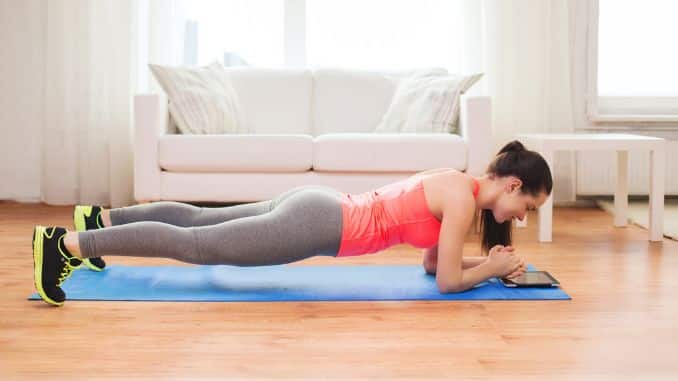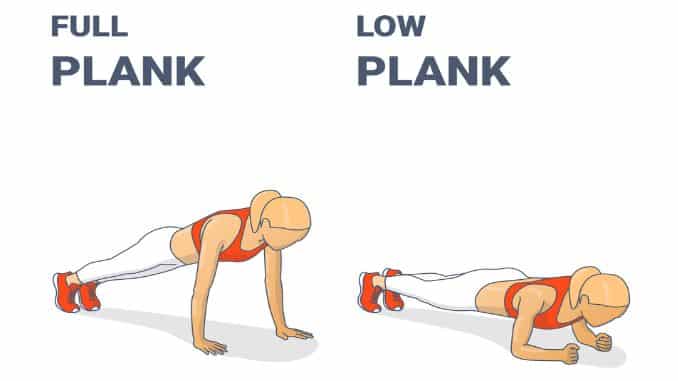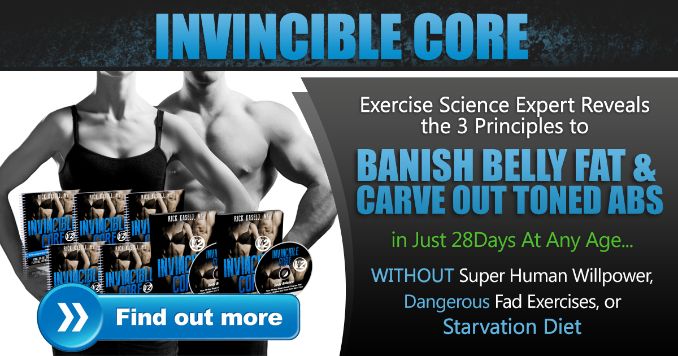A plank is an isometric exercise that strengthens the core, targeting muscles [1] like the transverse abdominis, obliques, and rectus abdominis. Additionally, this beginner-friendly move improves posture and core stability.
Planks enhance core stability, strengthen muscles, improve posture, and reduce low back pain.
4 Best Hand Positions When Doing Front Plank Exercise
1. Palms Down
Forearms in lined up with the shoulders with palms down. This is a common best-hand position when doing which helps you balance during the front plank exercise. With the elbows up, you are working the shoulder at 90 degrees of external rotation which is good for shoulder health. This position also allows you to activate your scapular stabilizers and lats which help protect the shoulder and lower back.
Remember to keep the elbows below the shoulders in order to decrease the stress on the shoulder, especially the rotator cuff.
2. Palms Facing Each Other
If you want to make the front plank more challenging, have your palms face each other so you are getting less help when balancing out with the hands. This will allow you to rely more on your core to stabilize and balance yourself out
3. Triangle Position
You get more help on the forearms when doing the triangle position. This is good for someone who is not able to get into the 90 degree external rotation of the shoulder. It put less stress on the shoulder than hand position #1 and #2.
4. Gentle Position
This is a very powerful position as you get lots of help from the forearms and the shoulder to create a stable position. This is a good position if you do a front plank into a side plank and then back into a front plank position. This tends to put the shoulder in its best and safest position.
Muscles Targeted in Planks
- Rectus Abdominis: Commonly known as your “abs.”
- Obliques: Muscles along the sides of your abdomen.
- Transversus Abdominis: Additionally, deep core muscles that wrap around your sides and spine.
- Other Supporting Muscles: Glutes, hamstrings, and lower back.
Hand Placement and Body Positioning
- Start in a hand plank position with your arms extended, hands directly beneath your shoulders.
- Then, dorsiflex your ankles, so your toes are pointed into the floor and supporting your weight.
- Keep your spine in proper alignment, drawing your navel in toward your spine and squeezing your glutes.
- Moreover, maintain a straight line from your heels to your shoulders.
- Palms should be flat on the floor, with fingers spread wide.
Plank with Correct Hand Placement
- Begin in a forearm plank with your elbows aligned below your shoulders, forearms resting flat on the mat.
- Then, tighten your core and press your toes into the ground.
- Moreover, move into a full hand plank position, ensuring your head, shoulders, hips, and toes form a straight line.
Harvard Medical [2] suggests starting by holding the plank for up to 30 seconds, then lowering your body and resting. Additionally, take several deep breaths, inhaling through your nose and exhaling through your mouth. Moreover and return to the starting position. Repeat the movement.
A Physical Therapist from Washington DC advises that you keep your body straight and avoid letting your back sag. This helps you work the right muscles in your core and shoulders. Moreover, hold the position for the suggested amount of time, and make sure your back stays straight to prevent strain.
Tips for Effective Planks

- Start with shorter holds and gradually increase the duration as you build strength and endurance.
- Then, focus on achieving the proper hand position for the front plank to maximize core engagement and prevent injuries.
- Use an exercise mat or floor for comfort and support.
- Moreover, try different variations of planks, such as forearm planks or side planks, to target different muscle groups.
- With consistent practice, you can increase the duration of your plank hold, both independently and with support.
Plank Exercise Benefits

- Increased Muscle Strength and Endurance: Builds strength in the core, arms, and shoulders, improving endurance.
- Better Flexibility: Enhances the range of motion in muscles and joints.
- Enhanced Cardiopulmonary Fitness [4]: Boosts heart and lung function.
- Improved Body Composition: Builds stronger muscles, helps burn calories more efficiently, and reduces body fat.
Conclusion
Proper hand placement in a front plank [3] is crucial for effective form and optimal results. By following these tips and guidelines, you can improve your core strength and stability, reduce low back pain, and enhance your overall fitness.
If you are looking for more exercises that help strengthen your core, tighten your abs, slim your waist and flatten your stomach while keeping yourself injury free, then check out the Invincible Core program here:
FAQ’s
Where should you position your hands for a high plank?
Position your hands directly under your shoulders with your fingers spread wide for stability.
What is the proper form for a front plank?
For proper form in a front plank, keep your body in a straight line from your head to your heels. Engage your abdominal muscles by tightening your core and avoid letting your back sag. Your shoulder blades should be pulled back, and your shoulder girdle should be strong and stable. Make sure your back stays in a neutral position to prevent strain.
How do you position your arms for a plank?
When positioning your arms for a plank, maintaining the proper arm position for a front plank is essential for stability and injury prevention. If doing a forearm plank, keep your forearms flat on the ground, parallel to each other. For a high plank, ensure your hands are directly under your shoulders. Keep your core tight and focus on a neutral spine to protect your back.
What position should you hold a plank?
Hold the plank for the recommended time, keeping your body straight and strong while maintaining a neutral position with your back.


